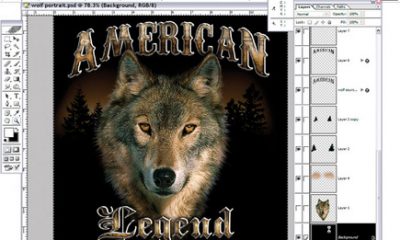Digital Printing
Published
20 years agoon
Replicate the original artwork. Lay down a controlled thickness of ink. That is what we do. And with screen printing, we can achieve a degree of flexibility that is unavailable to other printing processes. We can lay down ink-film thicknesses from fractions of a micron to 300 microns and print on areas that range from a few microns to several square meters in size. Our choice of substrates is enormous. And if it is a fluid or can be suspended in a fluid, it can be screen printed. The limiting factor is that it has to be able to pass through a commercially available mesh.
Even with all these benefits, the increasing influence of digital printing on the screen-printing process seduces some businesses into simply ditching all screen-printing technology and expertise and turn to the squeeze-and-squirt inkjet process as the way to future prosperity. But doing so can make a company very vulnerable.
As digital technology advances, the level of skill required to operate a digital press shrinks, opening the market up to increasing numbers of producers. Those wonderful profit margins of three to four years ago are being eroded. Staying on the technological edge is very expensive, and you need the sales and profits to do it. A five-year-old inkjet printer is nearly obsolete, whereas a five-year-old screen-printing press is still in its prime. Yes, screen printing has taken a caning on profits, but that is attributable more to the downturn in the market and excess capacity, rather than advances in digital technology.
The state of the market
Let us not kid ourselves. Inkjet printing is a process for now and the future. This technology is highly competitive and dynamic, with some 200 patents being filed every month! It has, however, reached a technological plateau, and major equipment manufacturers are going to face enormous threats from machines made in China within the next few months. Wide- and grand-format inkjets will soon be sold at half the price offered by existing market leaders. Such competition is bound to bring a response from the main players. It may force them into some redesigning exercises or cause them to move manufacturing to China in order to reduce their own prices.
In a conventional marketplace, when the plateau is reached after a period of investment in R&D and product development, manufacturers can consolidate their resources and prepare for the next series of advances. With the introduction of Chinese inkjets, this consolidation period is no more, and those who were expecting it place themselves in a precarious position.
From the users’ point of view, is it best to buy now or wait for the much cheaper equipment? If we buy now, will our suppliers still be in business once the lower-cost machines hit the market? When the Chinese machines are readily available, will the technical and service backup be as good as before? Could we be seeing the same kind of meltdown in the digital-equipment market that was forecast for the screen equipment market in the mid 1990s? Of course not, but the current trends mean you have to give even more careful consideration to the direction in which you plan to take your business.
Examining screen-printing and inkjet technologies
Dyes were the original colorants used for making inkjet inks, and many lower-priced inkjet printers still use them. They are soluble in a liquid carrier–water or solvent–and they offer high color saturation and bright colors; however, they are not completely light-stable. On the other hand, new pigmented ink systems offer light stability. But they have to be ground to a size matched to the nozzle diameters of the inkjet’s printheads. These are typically between 20-80 microns, depending on the technology and application. The required pigment-particle size is typically less than 1 micron for industrial inkjet applications and less than 200 nanometers for office applications. With screen printing, the pigment size is only limited by the mesh opening, and that can be changed in minutes for the cost of a stencil.
Screen-printing technology may not be as sexy as digital, but by using digital technology within the screen-printing process, the advantages can be tremendous. Add this to the inherent adaptability of screen printing and you have a very powerful profit producer. Rather than abandoning screen printing, consider maximizing its ability to generate profits. Judge what you can do with screen printing that is not possible with digital printing, and do it as well as you possibly can.
What is not practical with the squeeze-and-squirt process? (I must stop using that term.) Simply put, changes in ink type through the same nozzle system and the use of any ink type that is not designed specifically for the delivery system both create problems. The screen-printing industry is built on an ability to be extremely flexible in terms of the inks or media used and the variety of applications.
Digital printing has had a key influence on graphics screen printing in that the client demands much more from the screen process. No longer acceptable are golf-ball-sized halftone dots and flesh tones that range from fevered to jaundiced in the same print run. The client wants the vibrancy and consistency that is characteristic of high-end digital printing.
Incorporating digital technology into the screen-printing workflow through the use of direct-to-screen imaging is now a well-accepted practice. (Please, Father Christmas, this year will you bring me a flatbed, laser-guided, focused, UV-based stencil-imaging system or a high-quality inkjet unit? If so, I promise not to say squeeze-and-squirt ever again.) The hot-wax stencil-imaging devices, along with direct projection, have largely replaced traditional photo-based large-format film positives for display applications. Which of these two technologies is best actually is a matter of opinion–probably direct projection for speed and economy and hot wax for quality and flexibility. As with all systems, it is down to the application of best practice. Bad practice can screw up the best technologies. Those who are fortunate use both systems side by side with good results.
As with all such techniques, talk to a current user about their experiences. Salesmen have an unfortunate habit of saying “All you do is….” You have to consider the impact the chosen technique can have on your operation.
Direct projection will require a controlled environment–humidity being crucial. Additionally, the range of fast emulsions available for direct projection inhibits the use of water-based inks. The photopositives used in this process, though small, have to be spotless and free of faults. At 40 lines/in., a tonal range from 2-98% is now attainable by the finer exponents of direct projection. Hot-wax stencil-imaging devices are increasing in speed, and regular maintenance of the heads maintains imaging quality and reliability.
Stable screen frames are crucial with both systems. A warped frame will throw the direct-projection image out of focus. And in the hot-wax systems, even though the current models will follow the profile of a bowed frame, making these course corrections slows productivity.
Putting the technologies together
Where the marriage of screen and digital printing has its greatest potential for success is in proofing of screen-printed jobs with a digital printer. Traditionally, we have used screen-printed press proofs at considerable cost. Other options include digital proofs or Chromalin proofs. The latter are produced using the DuPont system of mixing colored dye powders to approximate Pantone Matching System colors, putting them into a solution, and then applying them to a carrier substrate. These techniques make obtaining a true representation of the finished screen print virtually impossible.
However, refinements in digital proofing technology are giving us the opportunity to produce more realistic simulations of screen-printed images. The RIP outputs actual dot patterns at the specified angles that duplicate the density and hue characteristics of the supplier’s process-color inks for screen printing. The system also can apply calibration curves for individual screen-press/substrate combinations to bring the proof even closer to the color characteristics of the screen-printed image. Further developments feed print characteristics of individual screen presses back into the system. Of course, this only works if the printer and stencil technician control the process.
Accurate proofing requires a discipline for production that is inescapable. This discipline is equally applicable to the prepress department, which can see the results of its efforts before the first squeegee stroke.
As screen printers become more efficient in using digital tools, they can reduce costs and boost profits. By doing so, they can ensure that screen-printing technology remains viable and presents an even greater challenge for digital printing to overcome. The overall result will be the expansion of the market for display graphics, where printers provide comprehensive solutions–not just screen printing or digital printing, but any process that satisfies customers and is profitable to the business. It’s the happy marriage we all seek.

Subscribe

Magazine
Get the most important news
and business ideas from Screenprinting Magazine.
Most Popular
-

 Case Studies2 months ago
Case Studies2 months agoHigh-Density Inks Help Specialty Printing Take Center Stage
-

 Art, Ad, or Alchemy2 months ago
Art, Ad, or Alchemy2 months agoF&I Printing Is Everywhere!
-

 Andy MacDougall2 months ago
Andy MacDougall2 months agoFunctional and Industrial Printing is EVERYWHERE!
-

 Columns3 weeks ago
Columns3 weeks ago8 Marketing Mistakes Not to Make When Promoting Your Screen Printing Services Online
-

 Editor's Note3 weeks ago
Editor's Note3 weeks agoLivin’ the High Life
-

 Marshall Atkinson3 weeks ago
Marshall Atkinson3 weeks agoHow to Create a Winning Culture in Your Screen-Printing Business
-

 Thomas Trimingham2 months ago
Thomas Trimingham2 months ago“Magic” Marketing for Screen Printing Shops
-

 Case Studies3 weeks ago
Case Studies3 weeks agoScreen Printing for Texture and Depth






